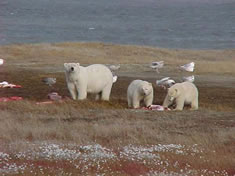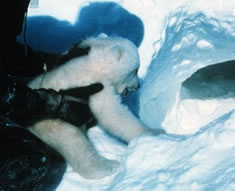

The hair of a polar bear looks white because the air spaces in
each hair scatter light of all colors. The color white becomes
visible to our eyes when an object reflects back all of the visible
wavelengths of light, rather than absorbing some of the wavelengths.
At one time it was suggested that the polar bear hairs might
have some of the properties of optical fibers. Apparently this
is not the case. See the following Web sites for information and
additional links:
Debunking the Myth of Polar Bear Hair - Article 1390 from the
Alaska Science Forum
http://www.gi.alaska.edu/ScienceForum/ASF13/1390.html
Complete Polar Bear Fact and Story Web site http://www.geocities.com/mikepolarbear/big_guess.html
Scientists in the late 1970’s discovered another interesting
tidbit about polar bears. A number of polar bears in zoos from
around the world were turning green! These scientists discovered
that the algae responsible for making the bears green were not
on the SURFACE of the hairs, as originally supposed, but were INSIDE
the hairs (Lewin & Robinson, 1979). The algae more than likely
came from the pond waters in the bears’ enclosures.
 Related
Web Sites Related
Web Sites |
- What
is the largest bear on earth? - Everyday Mysteries:
Fun Science Facts from the Library of Congress.
- Polar
Bears International - Polar Bear International
is a non-profit group dedicated to the conservation
of the polar bear. Web site includes bear facts, photographs,
information and research.
- Polar
Bears: National Wildlife Federation - This Web
site from the National Wildlife Federation contains
the following categories: polar bear facts, behaviors,
magazine articles, polar bear conservation, and activities
for kids and parents.
- What
has been happening to polar bears in recent decades? From
NOAA Arctic Theme pages. In addition to discussing
the ecology of polar bears, this Web site provides
a gallery of polar bear photographs and links for more
information about polar bears and climate change.
|
 Further
Reading Further
Reading |
- Brown,
Gary. The great bear almanac. New York, Lyons & Burford,
1993. 325 p.
- Bruemmer,
Fred. How polar bears break the ice. Natural history,
v. 93, December 1984: 38-47
- Davids,
R.C. Lords of the arctic: a journey among the polar
bears. New York, MacMillan, 1982. 140 p.
- Lewin,
Ralph A., and Phillip T. Robinson. The greening of polar
bears. Nature, v. 278, March 29, 1979: 445-447.
- Patent,
Dorothy Hinshaw. Polar bears. Minneapolis, Carolrhoda
Books, c2000. 48 p. (Juvenile literature)
|
 For
more print resources... For
more print resources...
Search on "polar
bears" and "bears"
in the Library of Congress Online
Catalog.
|

NASA's Ocean Surface Topology from Space. http://sealevel2.jpl.nasa.gov/jr_oceanographer
/oceanographer-swift.html

From the Arctic Theme Page at National
Oceanic and Atmospheric Administration,
http://www.arctic.noaa.gov/gallery/
polarbear.html

Cub being tagged for observation. NOAA Photo Library. http://www.photolib.noaa.gov/historic/c&gs
/theb3717.html
|




